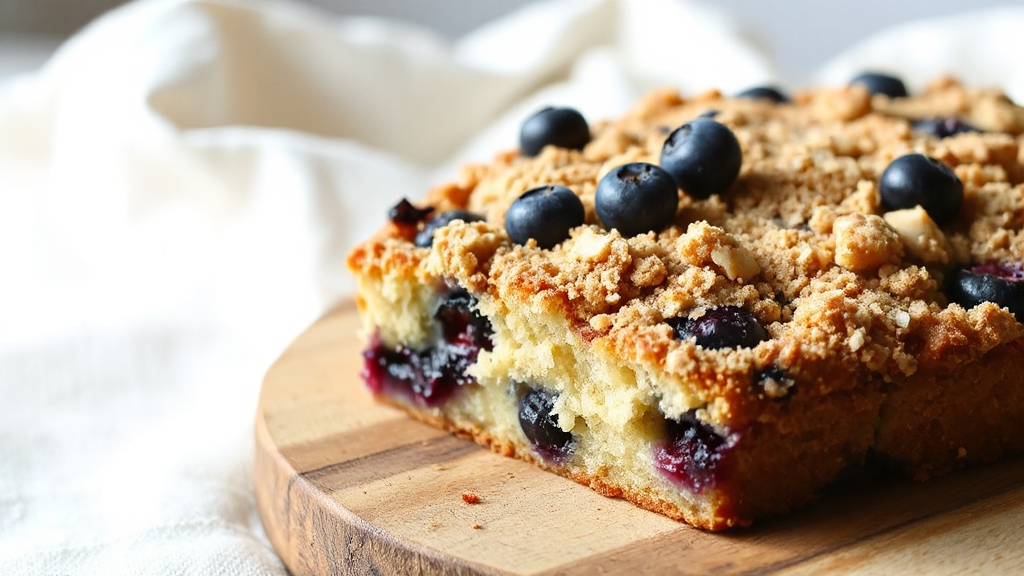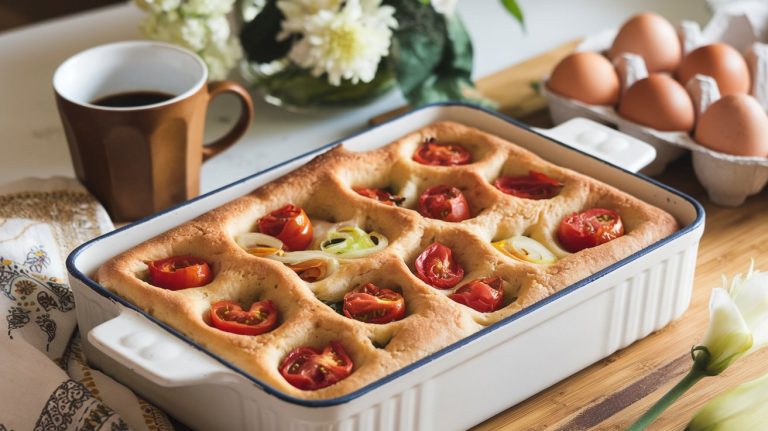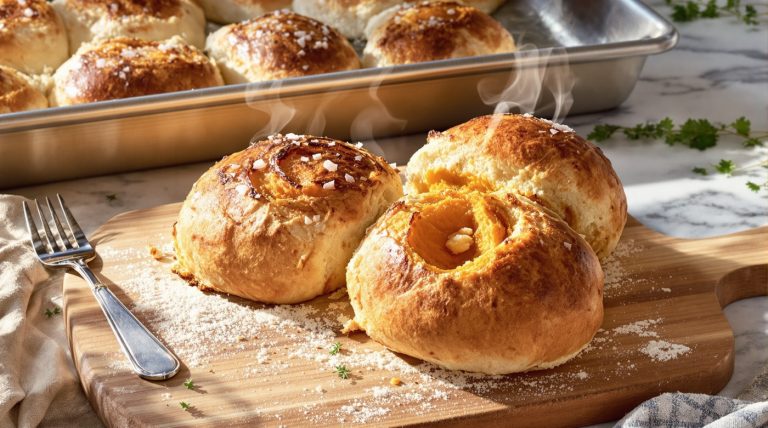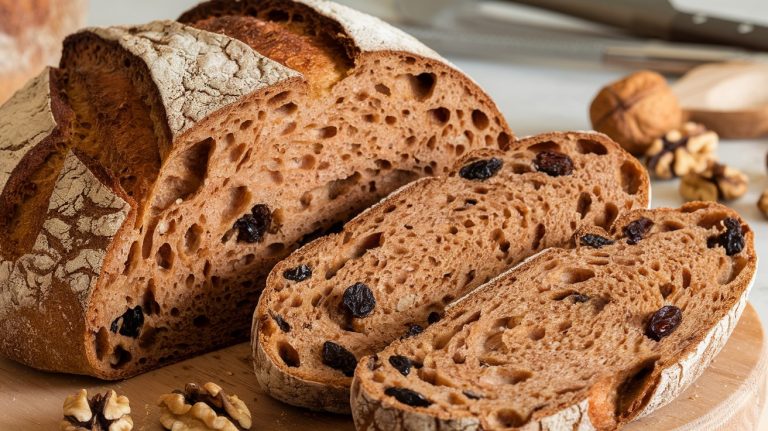Sourdough Blueberry Crumb Cake: A Slice of Comfort and Joy
What if you could transform your neglected sourdough discard into a bakery-worthy masterpiece that rivals any coffee shop treat? This isn’t just another crumb cake recipe—it’s your gateway to mastering the art of sourdough baking with juicy blueberries and a perfectly crispy topping.
You’ll discover the secret to preventing fruit from sinking, learn professional layering techniques that ensure every bite bursts with flavor, and unlock storage methods that keep your creation fresh for days. Ready to elevate your baking game and create something truly extraordinary?
Key Takeaways
- Coat blueberries in flour before folding into sourdough batter to prevent sinking and ensure even fruit distribution.
- Prepare a crumb topping with melted butter, sugar, flour, and spices for a crisp yet tender texture.
- Bake the cake at 350°F on the middle rack for an even golden crust and moist crumb.
- Use a mature sourdough starter, bubbly and doubled in size after 7-14 days, for best flavor and rise.
- Store the cake airtight in the fridge up to 6-7 days or freeze slices for up to a month.
Essential Ingredients for Sourdough Blueberry Crumb Cake
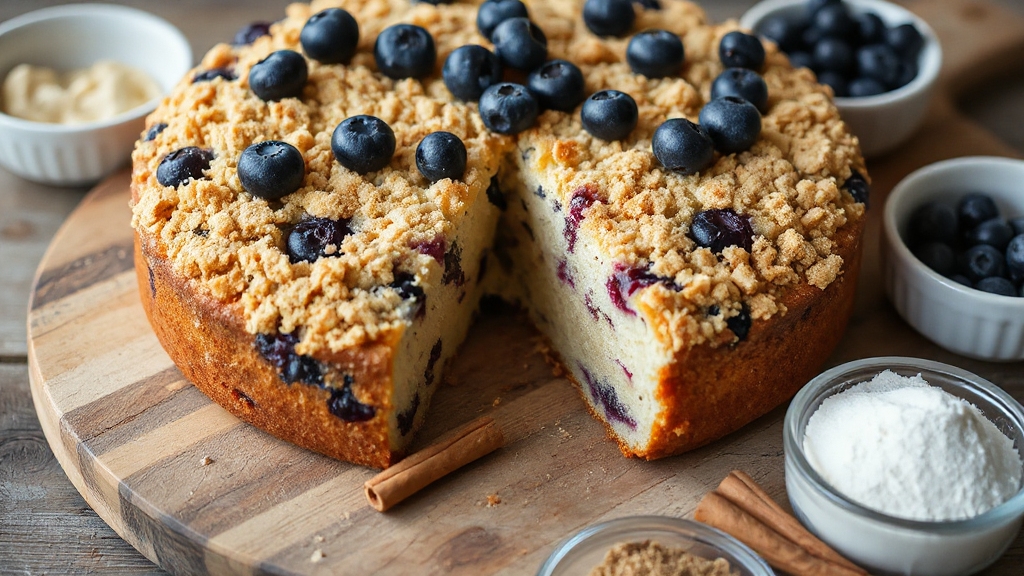
To bake a perfect sourdough blueberry crumb cake, you’ll want to gather a carefully balanced mix of ingredients that work together to create its signature texture and flavor.
Start with all-purpose flour as your dry base, complemented by a touch of cornstarch to keep the cake tender and absorb moisture from the juicy blueberries. Using a mix like the Krusteaz Sourdough Bread Mix can inspire similar artisan textures in your baking.
You’ll need baking powder and baking soda for that perfect rise, along with salt to enhance the flavors. Sweeten the batter with granulated or brown sugar. For richness, use unsalted butter and add moisture with eggs, sour cream or buttermilk, and a splash of milk if needed.
Vanilla extract will deepen the flavor. Sourdough starter discard (preferably 100% hydration) adds depth of flavor, though thicker starters may require additional liquids like milk.
Don’t forget the star: your sourdough starter or discard, which adds a subtle tang and complexity. Finally, toss fresh or frozen blueberries in flour to keep them suspended evenly in the batter.
Preparing the Sourdough Starter for Baking
Although starting a sourdough starter may seem intimidating, you’ll find it’s a straightforward process that sets the foundation for your blueberry crumb cake’s unique flavor.
Begin by mixing 60 grams each of flour and water using a fork until smooth and thick. Keep your starter in a warm spot, ideally around 75°F—try an oven with the light on or a proofing box.
The wild yeast present in the flour and air will naturally begin the fermentation process. This natural fermentation process relies on wild yeasts and bacteria, which contribute to the distinctive sourdough taste.
Let it rest for 24 hours before the first feeding. To maintain its vitality, feed it regularly with equal parts starter, flour, and water.
Watch for bubbles and a tangy aroma—signs your starter is lively and ready.
After 7 to 14 days of consistent feeding, your starter will be frothy and nearly double in size, perfect for mixing into your cake batter.
Crafting the Perfect Crumb Topping
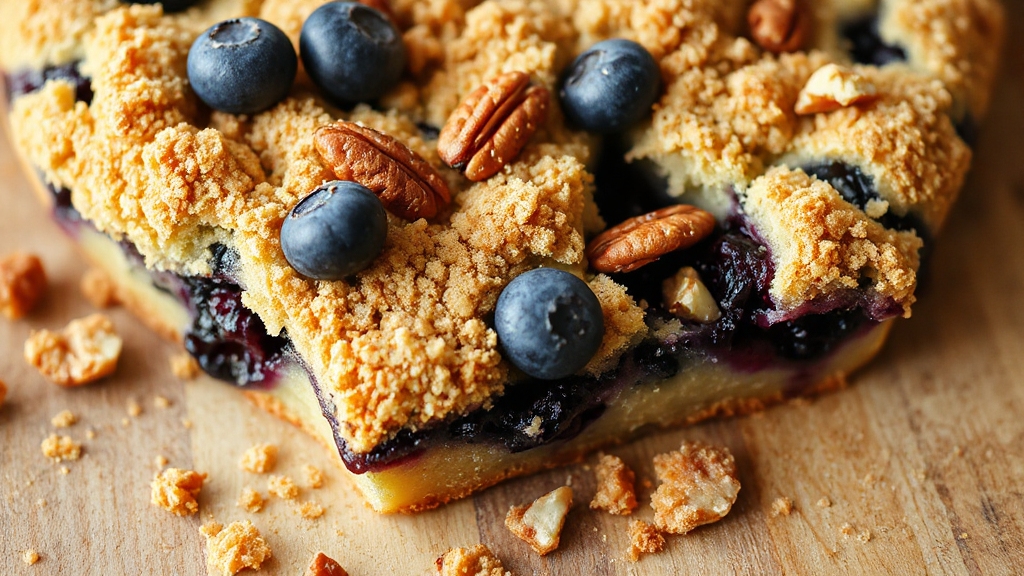
You’ll want to start with the right blend of key ingredients—like butter, flour, sugar, and a hint of vanilla—to build that irresistible crumb topping. Melted butter is combined with dry ingredients to create a crumbly topping. Getting the texture just right means balancing moisture and crumble, so it’s crisp without being dense or tough.
This balance is similar to the careful hydration process used in autolyse for dough development. With the perfect mix, your topping will add a delightful crunch that contrasts beautifully with the tender sourdough blueberry cake beneath.
Be sure to dot the top with additional blueberries, pressing them into the crumb for even distribution and added burst of flavor, which enhances the blueberry crumb topping.
Key Crumb Ingredients
When crafting the perfect crumb topping, you’ll find that the key ingredients work together to create a delicate balance of texture and flavor. Flour forms the sturdy base, while sugar—granulated or brown—adds sweetness and crunch. The choice of flour can influence the overall flavor, as whole grain flour tends to add more complexity.
Butter, whether cold for a textured crumb or melted for uniformity, binds everything, lending richness and that irresistible crumbly feel. Incorporate a pinch of salt to sharpen the flavors and a splash of vanilla extract for subtle warmth.
Spices like cinnamon or nutmeg deepen the profile without overpowering. You might add cornstarch to keep the topping crisp and prevent sogginess. Avoid leavening agents—they can cause unwanted rising. Using melted butter typically results in a more uniform crumb topping that enhances crumb texture.
Achieving Ideal Texture
To achieve the ideal texture in your sourdough blueberry crumb cake, you need to balance moisture and crumbly richness carefully. Start by mixing melted butter with sugar and flour, ensuring the topping stays moist yet crumbly. Incorporate brown sugar for added depth and a slight chewiness.
Sprinkle cinnamon or vanilla to enhance flavor complexity. Spread the crumb topping evenly over the cake surface to guarantee uniform browning and an inviting crunch, as temperature control during baking affects the crust development.
Meanwhile, handle your 100% hydration starter gently and fold in blueberries coated lightly with flour to prevent sinking. Using sourdough discard in the batter enhances flavor and texture in baked goods. Mix ingredients just until combined—overmixing stiffens the crumb. Bake at 350°F, watching for a clean knife test.
Mixing the Cake Batter With Blueberries
Although mixing the cake batter requires careful attention, incorporating the blueberries is where the magic truly happens. Before folding them in, toss the 2.5 cups of fresh blueberries lightly with flour to prevent sinking. Gently fold them into the thick, creamy batter, using a spatula to avoid crushing the delicate fruit. This ensures bursts of juicy sweetness throughout your cake.
For optimal results, consider the effects of resistant starch formation on texture and flavor when incorporating fruit into batters. Watch the batter transform as plump berries nestle evenly, promising flavorful bites in every slice.
You can also use frozen blueberries, either thawed or straight from the freezer, which is a convenient and cost-effective option for year-round baking, though fresh is usually preferred for the best texture and flavor fresh or frozen blueberries.
Layering Batter, Blueberries, and Crumb Topping
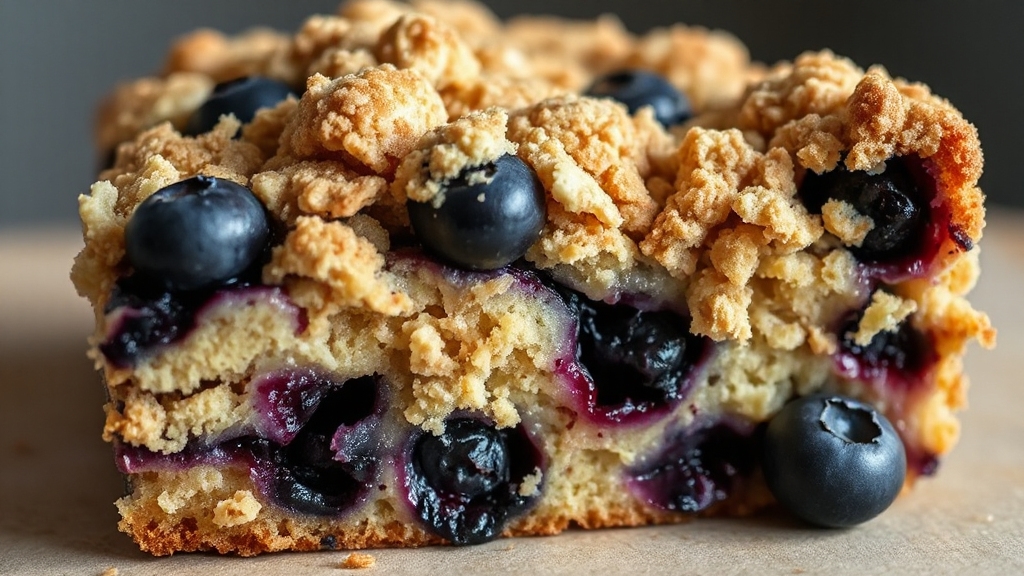
As you prepare to layer the batter, blueberries, and crumb topping, you’ll want to focus on creating distinct, flavorful strata that bake evenly and look stunning.
Start by pouring half the thick batter into your prepared pan. Then gently scatter half the flour-coated blueberries over it to prevent sinking. Using a waterproof cover like a shower cap can help keep the batter fresh if you need to pause.
Next, add the remaining batter, smoothing it gently to keep the berries suspended. Sprinkle the reserved blueberries atop for a beautiful finish.
Using frozen blueberries may require adjustments in baking time to ensure even cooking. Finally, evenly spread the moist, crumbly topping—made from melted butter, sugar, flour, and spices—breaking up clumps with your fingers to guarantee cohesive coverage.
This careful layering not only enhances the cake’s visual appeal but also aids even heat distribution, delivering a perfectly textured sourdough blueberry crumb cake.
Baking Tips for a Golden Brown Finish
You’ll want to set your oven to a steady 350 degrees F to achieve that perfect golden crust without burning. Baking at this temperature ensures even heat distribution, similar to the recommended 400°F for bagels to develop a golden brown crust.
Spreading the crumb topping evenly over the batter guarantees every bite gets a crisp, caramelized finish. This technique is akin to applying toppings evenly on bagels before baking to maintain consistent texture.
Keep the cake centered in the oven to promote even heat circulation and a beautifully browned top. Proper placement mirrors the advice to swap baking sheets halfway to ensure uniform baking.
Incorporating fika into your baking routine can enrich the experience by encouraging a mindful and social moment as you wait for the cake to bake. This pause aligns with recommended resting times in sourdough recipes, allowing dough or batter to develop enhanced texture and flavor.
Optimal Oven Temperature
When you set your oven between 340°F (170°C) and 350°F (175°C), you create the perfect environment for baking a sourdough blueberry crumb cake that boasts a beautifully golden brown crust. This temperature range balances gentle heat to evenly cook the cake while encouraging the crumb topping to caramelize without burning.
Because every oven distributes heat differently, keep a close eye on your cake during the last 10-15 minutes to catch any early browning. Using a metal baking dish can speed baking by conducting heat efficiently, so adjust time accordingly—usually 40 to 60 minutes.
Position your cake on the middle rack to ensure even exposure, and consider using an oven thermometer to verify accuracy. These steps help you achieve that perfect golden finish you’re aiming for. For the best results, choose a thermometer with temperature accuracy within ±1°F to ensure precise baking conditions.
Even Crumb Distribution
Achieving a golden brown finish on your sourdough blueberry crumb cake depends not just on oven temperature but also on how evenly the crumb develops throughout.
To get that perfect crumb, handle your dough gently—light kneading and folding preserve air bubbles essential for uniform texture. Incorporating psyllium husk can also improve crumb elasticity and moisture retention, contributing to an even texture.
Control fermentation carefully; aim for 75-80% proofing to avoid dense or overly airy patches. When shaping, keep the dough tight but gentle to maintain bubble structure, and ensure ingredients are well integrated with balanced hydration.
Additionally, paying attention to shaping techniques can greatly influence the distribution of air holes throughout the crumb, helping to avoid concentration near the crust. Finally, bake with even heat and cool properly to set the crumb.
Variations and Ingredient Substitutions
Although the classic sourdough blueberry crumb cake has its charm, exploring variations and substitutions allows you to tailor the recipe to your taste and dietary needs.
You can enrich the crumb topping by swapping white sugar for brown sugar or adding chopped walnuts and a hint of cinnamon or cardamom.
For a dairy-free twist, try coconut oil instead of butter.
In the cake, adjust liquid based on your sourdough starter’s hydration, or replace eggs with flax eggs for a vegan option.
Experiment with whole wheat or oat flour for nuttier depth, and swap buttermilk with non-dairy yogurt.
Mix blueberries with raspberries or dried cherries for a burst of flavor.
Don’t forget lemon zest or vanilla extract—they brighten and deepen the cake’s aroma beautifully.
Serving Suggestions and Presentation Ideas
You’ll find that serving sourdough blueberry crumb cake offers endless possibilities to delight your guests and elevate any occasion. For a cozy brunch, pair it with scrambled eggs or quiche and a fresh cup of coffee or herbal tea. Add extra blueberries or a sprinkle of cinnamon on top to enhance flavor and aroma.
Present your cake on a cake stand, dusted with powdered sugar for a delicate finish, or bake it in a cast iron skillet for rustic charm. Garnish with fresh mint or edible flowers to brighten the plate. The cake can be served warm or at room temperature, which brings out its tender texture and sweet crumb best.
For dessert, serve it alongside vanilla ice cream or a drizzle of blueberry sauce. Whether for holiday brunches, outdoor picnics, or family gatherings, this cake always shines beautifully.
Storage and Freshness Maintenance Tips
When you want to keep your sourdough blueberry crumb cake tasting as fresh as the day it was baked, proper storage is key. Store your cake in an airtight container or ziplock bag to lock out moisture and air, preserving its tender crumb. For best results, place the cake in a deep-sided pan if not using a springform pan to prevent damage during storage.
At room temperature, enjoy it within three days, but expect some moistening after the first day due to the juicy blueberries.
For longer storage, refrigerate the cake up to 6-7 days; chilling firms it up and controls humidity effects.
If you want to save it longer, freeze the whole cake or individual slices in freezer bags for up to a month. Thaw at room temperature or microwave briefly.
Always check for mold or off smells before serving to ensure freshness and safety.
Frequently Asked Questions
Can I Use Gluten-Free Flour for This Sourdough Blueberry Crumb Cake?
You can definitely use gluten-free flour, but be ready for a different texture and rise since gluten’s key for structure.
You’ll want a gluten-free sourdough starter and add binders like xanthan gum or psyllium husk to keep things together.
Adjust hydration and leavening too, because gluten-free batters behave differently.
Expect to experiment a bit—try small batches first to perfect moisture, crumb, and baking time for the best results.
How Do I Prevent Blueberries From Sinking to the Bottom During Baking?
You can prevent blueberries from sinking by first pouring a bit of batter into your pan and letting it set slightly. Then, gently fold the blueberries into the remaining thicker batter to keep them suspended evenly. Try layering batter and berries alternately for better distribution.
Avoid just tossing berries in flour—it doesn’t work well. Also, baking at a moderate temperature helps maintain the structure, keeping those juicy berries perfectly placed throughout.
What Is the Best Way to Freeze Leftover Crumb Cake Slices?
To freeze leftover crumb cake slices, first let them cool completely to avoid moisture buildup.
Flash freeze the slices on a baking sheet for an hour to preserve texture.
Then, wrap each slice tightly in plastic wrap, followed by a layer of aluminum foil for extra protection.
Place the wrapped slices in an airtight container or freezer bag, label with the date, and store them for up to three months for the best taste and freshness.
Can I Make This Cake Dairy-Free Without Affecting Texture?
You can absolutely make the cake dairy-free without sacrificing texture. Swap butter for vegan butter or coconut oil in both the crumb topping and cake to keep that rich, crumbly feel. Use non-dairy milks like almond or soy milk, and replace yogurt with coconut or soy yogurt to preserve moisture.
Just adjust liquid amounts carefully, and your crumb topping will stay delightfully crisp, while the cake remains moist and tender.
How Long Should the Sourdough Starter Be Fed Before Baking?
You should feed your sourdough starter about 6 to 8 hours before baking to make sure it’s at peak activity.
Aim for a 1:1:1 ratio of starter, flour, and warm water, and keep it in a warm spot.
Watch for it to double or triple in size and become bubbly with a pleasant sour smell.
This timing gives you a lively, well-fermented starter that’ll boost your bake’s rise and flavor beautifully.
More Than Cake—It’s a Hug in Every Bite
By now, you’ve crafted a delightful masterpiece that’s more than just a cake—it’s a gentle hug in crumb form, with blueberries bursting like little pockets of joy. As the golden crust invites you in, remember this isn’t just baking; it’s a moment of sweet escape.
Whether shared or savored alone, your sourdough blueberry crumb cake whispers comfort and celebration with every bite—proof that sometimes, the simplest pleasures are the most unforgettable.

